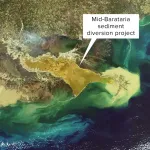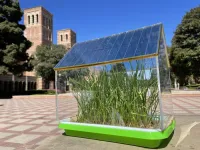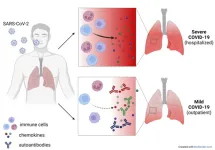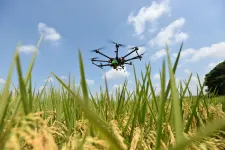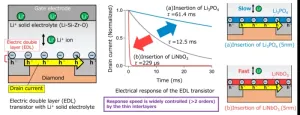(Press-News.org) A group of scientists from Durham University and University of York have twisted molecules to their breaking point in order to challenge the understanding of chemical bonds.
The researchers explored how far the chemical bonding in an aromatic ring can be twisted before its aromatic bonding breaks.
They achieved this by making overcrowded aromatic rings. Rather than benzene, they used tropylium, which shares electrons around a ring of seven carbon atoms.
Each of these carbon atoms can be functionalised and having seven attachment points in the ring, rather than the six carbon atoms of benzene, allowed the researchers to cram more groups around the edge of the aromatic ring, causing more strain.
The researchers found that low levels of overcrowding made the ring twist, but without breaking its aromatic bonding.
By adding progressively larger groups around the edge of the ring, the team twisted the ring further, eventually causing the aromatic bonding to break.
The electrons no longer circle the seven carbon atoms and instead, the ring pinches across its middle to form two smaller flat rings.
Surprisingly, the researchers found there is a balance point, where the ring jumps back and forth between aromatic structure and the two smaller rings. One molecule made in this study spends 90% of its time as the pinched structure and 10% of its time as a larger aromatic ring.
Full study results have been published in the journal Nature Chemistry.
Reflecting on the study results, Dr Paul McGonigal of University of York, said: “In these overcrowded molecules, strain and aromatic bonding are delicately balanced. The structure, properties, and potential applications of a material are ultimately determined by this balance.
“The precise control over the twisting of our molecules is unprecedented.
“We were not only able to twist an aromatic molecule up to the maximum amount of strain it can tolerate, but also to discover what happens when we push beyond that limit. We hope this investigation is a step towards us being able to more routinely turn aromatic bonding ‘off’ and ‘on’ in a controlled manner.”
Project lead investigator, Promeet Saha of Durham University, said: “The reversible pinching and reopening of an aromatic ring are truly remarkable.
“Aromatic bonding is such a powerful stabilising force that we usually think of it being a constant presence. However, our findings demonstrate that it can be surprisingly dynamic.”
Chemical bonding in aromatic molecules is key to the structure, stability and function of chemicals such as drugs and plastics.
The research has been funded by the Engineering and Physical Sciences Research Council (EPSRC).
ENDS
Media Information
Dr Paul McGonigal from University of York/Durham University is available for interview and can be contacted on paul.mcgonigal@york.ac.uk.
Alternatively, please contact Durham University Communications Office for interview requests on communications.team@durham.ac.uk.
Pictures
Associated images are available via the following link: https://bit.ly/chemical-bonds
Source Information
“Rupturing aromaticity by periphery”, (2023), Promeet K. Saha, Abhijit Mallick, Andrew T. Turley, Aisha N. Bismillah, Andrew Danos, Andrew P. Monkman, Alyssa-Jennifer Avestro, Dmitry S. Yufit & Paul R. McGonigal, Nature Chemistry.
The paper will be available online after the embargo lifts: www.doi.org/10.1038/s41557-023-01149-6
An embargoed copy of the paper is available from Durham University Communications Office. Please email communications.team@durham.ac.uk.
About Durham University
Durham University is a globally outstanding centre of teaching and research based in historic Durham City in the UK.
We are a collegiate university committed to inspiring our people to do outstanding things at Durham and in the world.
We conduct boundary-breaking research that improves lives globally and we are ranked as a world top 100 university with an international reputation in research and education (QS World University Rankings 2023).
We are a member of the Russell Group of leading research-intensive UK universities and we are consistently ranked as a top 10 university in national league tables (Times and Sunday Times Good University Guide, Guardian University Guide and The Complete University Guide).
For more information about Durham University visit: www.durham.ac.uk/about/
END OF MEDIA RELEASE – issued by Durham University Communications Office.
END
Scientists twist chemical bonds beyond their limits
Embargoed until 1600 GMT on Monday 6 March 2023
2023-03-06
ELSE PRESS RELEASES FROM THIS DATE:
Siblings should be screened in cases of suspected child physical abuse
2023-03-06
Siblings of a child suspected of experiencing physical abuse should also be screened for abusive injuries, according to a new international consensus statement led by researchers at UCL (University College London) and Great Ormond Street Hospital for Children (GOSH).
The team of 27 researchers, from six different continents, are calling for a policy change to stop inconspicuous injuries being missed in contact children (i.e. siblings, cohabiting children, or children who are under the same care), and to help prevent further ...
Rewarding accuracy instead of partisan pandering reduces Republican-Democrat divide over the truth – study
2023-03-06
Offering a tiny cash reward for accuracy, or even briefly appealing to personal integrity, can increase people’s ability to tell the difference between misinformation and the truth, according to a new study.
The findings suggest that fake news thrives on social media not only because people are tricked into believing it, but also due to a motivational imbalance: users have more incentive to get clicks and likes than to spread accurate content.
Social psychologists from the University of Cambridge and New York University argue that their study, published in the journal ...
New study compares human contributions to Mississippi river delta land loss, hints at solutions
2023-03-06
Research from scientists at Louisiana State University and Indiana University reveals new information about the role humans have played in large-scale land loss in the Mississippi River Delta—crucial information in determining solutions to the crisis.
The study published today in Nature Sustainability compares the impacts of different human actions on land loss and explains historical trends. Until now, scientists have been unsure about which human-related factors are the most consequential, and why the most rapid land loss in the Mississippi River Delta occurred between the 1960s and 1990s and ...
UCLA engineers design solar roofs to harvest energy for greenhouses
2023-03-06
As countries around the globe seek sustainable energy sources and the U.S. endeavors to become a net-zero emissions economy by 2050, renewable energy sources such as solar panels are in high demand.
However, solar panels can take up significant space and are often difficult to scale. Enter the new field of agrivoltaics, which focuses on the simultaneous use of land for both solar power generation and agriculture. For example, replacing the glass in greenhouses with solar panels could power the lamps and water controls in the greenhouse, or even the whole farm. But how does one build solar panels that can absorb energy from sunlight without blocking the light ...
'Good autoantibodies' could help against long Covid
2023-03-06
Sometimes in the laboratory there are unexpected results. "Previously it had been observed that autoantibodies are common in severe Covid patients, those who end up in intensive care," says Jonathan Muri, postdoctoral fellow at the Institute for Research in Biomedicine (IRB, affiliated with the Università della Svizzera italiana) and co-author of the study. "Instead, in this case we discovered the opposite."
The autoantibodies in question neutralize chemokines, molecules that direct immune cell trafficking. "Chemokines are a bit like traffic lights: they tell our immune cells when and where to go in the case ...
Drones and deep learning: researchers develop a new technique to quantify rice production
2023-03-06
Rice, a major food crop, is cultivated on nearly 162 million hectares of land worldwide. One of the most commonly used methods to quantify rice production is rice plant counting. This technique is used to estimate yield, diagnose growth, and assess losses in paddy fields. Most rice counting processes across the world are still carried out manually. However, this is extremely tedious, laborious, and time-consuming, indicating the need for faster and more efficient machine-based solutions.
Researchers from China ...
Controlling electric double layer dynamics for next generation all-solid-state batteries
2023-03-06
In our quest for clean energy and carbon neutrality, all-solid-state lithium-ion batteries (ASS-LIBs) offer considerable promise. ASS-LIBs are expected to be used in a wide range of applications including electric vehicles (EVs). However, commercial application of these batteries is currently facing a bottleneck—their output is reduced owing to their high surface resistance. Moreover, the exact mechanism of this surface resistance is hitherto unknown. Researchers have alluded it to a phenomenon called the “electric ...
Study finds silicon, gold and copper among new weapons against COVID-19
2023-03-06
New Curtin research has found the spike proteins of SARS-CoV-2, a strain of coronaviruses that caused the COVID-19 pandemic, become trapped when they come into contact with silicon, gold and copper, and that electric fields can be used to destroy the spike proteins, likely killing the virus.
Lead researcher Dr Nadim Darwish, from the School of Molecular and Life Sciences at Curtin University said the study found the spike proteins of coronaviruses attached and became stuck to certain types of surfaces.
“Coronaviruses have spike proteins on their periphery that allow them to penetrate host cells and cause infection and we have found these proteins becomes stuck to the surface ...
Electronic messages improved influenza vaccination rates in nationwide Danish study
2023-03-06
Approximately one billion people are infected with influenza around the world each year, with more than half a million deaths estimated to result from the disease. Despite the disease’s potential severity, especially among older populations and those with cardiometabolic risk factors, approximately 30 percent of U.S. adults over age 65 were not vaccinated during the 2019-2020 flu season. To evaluate best strategies for increasing vaccination rates, researchers from Brigham and Women’s Hospital, a founding member of the Mass General Brigham healthcare ...
Quantifying genetic variations in bacterial cultures the qSanger way
2023-03-06
Genetic variations, such as mutations, recombinations, or transpositions occur naturally in cultured microorganisms and are often considered nonneutral mutations. Neutral mutations are neither beneficial nor harmful to an organism and only affect a small proportion of the total population. On the other hand, nonneutral mutations can affect a larger proportion of the population by potentially changing the gene pool, depending upon the advantages or disadvantages provided by the genetic variant. These ...
LAST 30 PRESS RELEASES:
University of Oklahoma researcher awarded funding to pursue AI-powered material design
Exploring how the visual system recovers following injury
Support for parents with infants at pediatric check-ups leads to better reading and math skills in elementary school
Kids’ behavioral health is a growing share of family health costs
Day & night: Cancer disrupts the brain’s natural rhythm
COVID-19 vaccination significantly reduces risk to pregnant women and baby
The role of vaccination in maternal and perinatal outcomes associated with COVID-19 in pregnancy
Mayo Clinic smartwatch system helps parents shorten and defuse children's severe tantrums early
Behavioral health spending spikes to 40% of all children’s health expenditures, nearly doubling in a decade
Digital cognitive behavioral treatment for generalized anxiety disorder
Expenditures for pediatric behavioral health care over time and estimated family financial burden
Air conditioning in nursing homes and mortality during extreme heat
The Alps to lose a record number of glaciers in the next decade
What makes a good proton conductor?
New science reporting guide published for journalists in Bulgaria
New international study reveals major survival gaps among children with cancer
New science reporting guide published for journalists in Turkey
Scientists develop a smarter mRNA therapy that knows which cells to target
Neuroanatomy-informed brain–machine hybrid intelligence for robust acoustic target detection
Eight SwRI hydrogen projects funded by ENERGYWERX
The Lundquist Institute and its start-up company Vitalex Biosciences Announces Strategic Advancement of Second-Generation fungal Vaccine VXV-01 through Phase 1 Trials under $40 Million Competitive Con
Fine particles in pollution are associated with early signs of autoimmune disease
Review article | Towards a Global Ground-Based Earth Observatory (GGBEO): Leveraging existing systems and networks
Penn and UMich create world’s smallest programmable, autonomous robots
Cleveland researchers launch first major study to address ‘hidden performance killer’ in athletes
To connect across politics, try saying what you oppose
Modulating key interaction prevents virus from entering cells
Project explores barriers to NHS career progression facing international medical graduates
Jeonbuk National University researchers explore the impact of different seasonings on the flavor perception of Doenjang soup
Two Keck Medicine of USC Hospitals named Leapfrog Top Teaching Hospitals
[Press-News.org] Scientists twist chemical bonds beyond their limitsEmbargoed until 1600 GMT on Monday 6 March 2023
